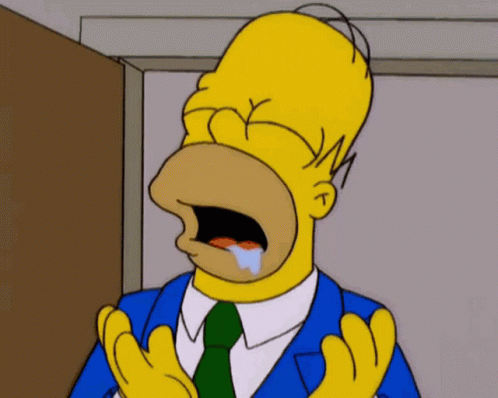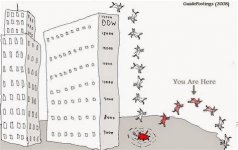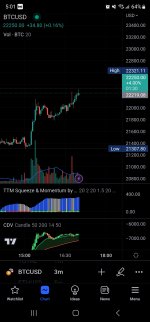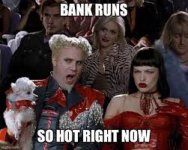You are using an out of date browser. It may not display this or other websites correctly.
You should upgrade or use an alternative browser.
You should upgrade or use an alternative browser.
ECON [FINANCE] First Deathburger Thread of the 2023 Banking Crisis. ALL welcome (hall passes at the door). Have At It.
- Thread starter night driver
- Start date
- Status
- Not open for further replies.
dstraito
TB Fanatic
SmithJ
Veteran Member

SVB, Signature Bank Depositors to Get All Their Money as Fed Moves to Stem Crisis
The Fed said it would make additional funding available to banks to ensure they have “the ability to meet the needs of all depositors.”
 www.wsj.com
www.wsj.com

SVB, Signature Bank Depositors to Get All Their Money as Fed Moves to Stem Crisis
The Fed said it would make additional funding available to banks to ensure they have “the ability to meet the needs of all depositors.”
SVB, Signature Bank Depositors to Get All Their Money as Fed Moves to Stem Crisis
U.S. regulators took control of a second bank Sunday and raced to roll out emergency measures to stem potential spillovers from Friday’s swift collapse of Silicon Valley Bank, backstopping both firms’ uninsured depositors and making more funding available to the banking system.Officials took the extraordinary step of designating SVB and Signature Bank as a systemic risk to the financial system, which gives regulators flexibility toguarantee uninsured deposits. The Federal Reserve and the Treasury Department also used emergency lending authorities to establish a new facility to help meet demands for withdrawals.
Regulators announced the action in a joint statement from Treasury Secretary Janet Yellen, Fed Chair Jerome Powell and Federal Deposit Insurance Corp. Chair Martin Gruenberg. The group said that depositors at SVB will have access to all of their money on Monday.
The government’s bank-deposit insurance fund will cover all deposits at the two banks, rather than the standard $250,000. Federal regulators said any losses to the government’s fund would be recovered in a special assessment on banks and that the U.S. taxpayers wouldn’t bear any losses.
What Does the Silicon Valley Bank Failure Mean?
Silicon Valley Bank collapsed on Friday, becoming the largest bank to fail since the 2008 financial crisis. On Monday, March 13, at 3:00 p.m. ET, join the Journal’s Wall Street and Financial Industry Bureau Chief Dana Cimilluca and reporter Rolfe Winkler for a conversation about the bank failure, subsequent regulatory action and what this all means for the tech sector and the overall health of the U.S. economy.
Sign Up
In a separate statement Sunday night, the Fed said it “is closely monitoring conditions across the financial system and is prepared to use its full range of tools to support households and businesses, and will take additional steps as appropriate.”
The central bank said it would make additional funding available to banks to ensure they have “the ability to meet the needs of all depositors” through a new “Bank Term Funding Program,” which will offer loans of up to one year to banks that pledge U.S. Treasury securities, mortgage-backed securities and other collateral. Up to $25 billion from the Treasury’s exchange-stabilization fund will backstop the Fed lending program.
Many of those securities have fallen in value as the Fed has raised interest rates, and the Fed said those securities would be valued at their original value.
Sunday evening’s announcement capped a frantic weekend during which regulators were auctioning the failed Silicon Valley Bank, according to people familiar with the matter. Regulators struggled to find a buyer on Sunday and pivoted to backstopping the deposits, according to a senior Treasury official, as they sought to announce a resolution to depositors by Monday morning.
Mr. Powell scrapped plans to attend a regular meeting of central bankers in Basel, Switzerland, on Sunday and instead stayed in Washington to manage the crisis response.
A U.S. plan that soothes nerves about access to uninsured deposits—most of the bank’s deposits are sizable enough that they exceeded limits on FDIC protection—could tamp down the crisis and limit any impact on the economy as the Fed has focused on combating inflation by raising interest rates.
At the same time, heavy-handed federal interventions could amount to an embarrassing coda for a rollback of post-financial-crisis regulations on small and midsize banks undertaken in recent years. Officials on Sunday signaled they were weighing tougher capital requirements and liquidity rules, reversing at least some of the steps taken during the Trump administration to ease restrictions on smaller banks.
Federal regulators are trying to balance their desire to prevent broader financial contagion while avoiding the damaging political optics of bailing out financial institutions at taxpayer expense.
Advertisement - Scroll to Continue
Biden administration officials said repeatedly on Sunday that their moves were aimed at protecting depositors, allowing them to make payroll this week, and would come at no cost to taxpayers. A senior Treasury official said the Fed’s lending program would prevent further bank runs.
Newsletter Sign-up
What’s News
Catch up on the headlines, understand the news and make better decisions, free in your inbox every day.
Nicholas Donahue, the co-founder of real-estate startup Atmos, said he was set to finalize a loan from Khosla Ventures to help make payroll payments for the coming week when he heard the news.
“I’m feeling relieved, the fact that I can go back to my team tonight and say the business will be fine,” Mr. Donahue said. “There’s just a lot of weight off of my shoulders.”
Signature and SVB are the highest-profile casualties of the Fed’s campaign to slow the economy and bring inflation down. The central bank has raised interest rates by 4.5 percentage points over the past year, the most rapid run-up since the early 1980s, and officials have signaled more increases are likely.
New York-based Signature is one of a handful of banks that went big on crypto, providing accounts and other services to crypto startups and big investors in digital assets. It ultimately became one of the crypto market’s leading banks.
That focus and a bespoke payments system for crypto companies helped the bank more than double deposits in two years. In early 2022, some 27% of its deposits were from its digital-asset clients.
The bank’s exposure to crypto became a problem as the year wore on. A market rout that deepened following the November collapse of Sam Bankman-Fried’s crypto exchange, FTX, drained billions of dollars in deposits.
Signature shares fell 23% on Friday, its worst day since it went public in 2004. The bank had $110 billion in assets, and $88.6 billion in deposits as of the end of 2022.
SVB faced its own unique set of challenges. Deposits at the bank surged after the pandemic, and federal policy response left tech companies flush with cash in 2021. The Santa Clara, Calif.-based lender saw total deposits mushroom to nearly $200 billion by March 2022, up from more than $60 billion two years earlier.
Because it invested much of that cash in longer-dated securities whose values have fallen as interest rates have shot up, it risked larger losses if it had to liquidate its securities portfolio. At the same time, its depositors were heavily concentrated in the tightknit world of startups and venture-capital firms, leaving the bank uniquely vulnerable to a run.
A slowdown in tech over the past year, together with rising deposit costs, meant more of its venture-capital-backed customers were burning cash or pulling deposits.
Startups yanked funds more aggressively last week to avoid potential losses on deposits in excess of the $250,000 limit insured by the federal government. Those withdrawals, encouraged by some venture investors, sparked a classic bank run that ended with the FDIC stepping in on Friday.
“All the banks that are close to looking like SVB are either going to reassure their depositors or not. And I’m assuming they’re going to because SVB is really such a special case,” said William Dudley, who was president of the New York Fed from 2009 until 2018. Protecting uninsured depositors “will make that task much easier,” he said.
The speed with which SVB collapsed stunned analysts. The bank was closed on Friday morning; typically, regulators attempt to close failing banks at the end of the week and announce a sale of the banks’ assets at the same time, using the weekend to transfer accounts.
SmithJ
Veteran Member

Circle’s USD Coin Steadies After Fed Backstop
Circle’s dollar-pegged cryptocurrency rose to 99 cents on Sunday after U.S. regulators announced it would backstop all Silicon Valley Bank depositors. USD Coin, the second-largest stablec
 www.wsj.com
www.wsj.com

Circle’s USD Coin Steadies After Fed Backstop
Circle’s dollar-pegged cryptocurrency rose to 99 cents on Sunday after U.S. regulators announced it would backstop all Silicon Valley Bank depositors. USD Coin, the second-largest stablec
Circle’s USD Coin Steadies After Fed Backstop
Circle’s dollar-pegged cryptocurrency rose to 99 cents on Sunday after U.S. regulators announced it would backstop all Silicon Valley Bank depositors.USD Coin, the second-largest stablecoin, fell below 87 cents over the weekend on news that Circle had $3.3 billion in reserves locked up in the collapsed bank. Stablecoin providers promise that each $1-valued coin has an equivalent dollar in cash and cash-equivalent reserves on hand for redemptions.
Investors redeemed billions of dollars of Circle’s USD Coin in fear that the stablecoin provider would not have enough reserves to honor redemptions, causing the value to plummet.
On Saturday afternoon, Circle said it would cover any shortfall in reserves from its company resources. On Sunday, the U.S. regulators promised to backstop uninsured deposits from Silicon Valley Bank so that customers would get all their money back.
night driver
ESFP adrift in INTJ sea
This'll work until the NEXT BIG one and the banks won't pony up.
And it is GOOD to see the Stable-coin firming up.
And it is GOOD to see the Stable-coin firming up.
Roger Thornhill
Some irascible old curmudgeon
I'm searching for a video which was posted several months ago. In it, a group of officials were discussing what they would do if they knew an economic collapse was imminent. They all agreed that it would be counterproductive to announce anything to the public. As one woman responded to this consensus, she remarked with a wink and a chuckle, "We'd actually prefer it happen on a Friday". All parties present smiled in agreement.
If you remember seeing this same video clip, please post a link.
If you remember seeing this same video clip, please post a link.
SmithJ
Veteran Member
New Acronym: the Buttf&$ker Program, or BTFP

Meet the BTFP, the Fed’s 2023 Crisis Facility
Among measures to counter fallout from the failure of Silicon Valley Bank, the Federal Reserve said it would create a new lending program for banks: the Bank Term Funding Program, or BTFP. The facility will allow banks to take advances from the Fed for up to a year by pledging Treasurys, mortgage-b
 www.wsj.com
www.wsj.com

Meet the BTFP, the Fed’s 2023 Crisis Facility
Among measures to counter fallout from the failure of Silicon Valley Bank, the Federal Reserve said it would create a new lending program for banks: the Bank Term Funding Program, or BTFP. The facility will allow banks to take advances from the Fed for up to a year by pledging Treasurys, mortgage-b
Meet the BTFP, the Fed’s 2023 Crisis Facility
Among measures to counter fallout from the failure of Silicon Valley Bank, the Federal Reserve said it would create a new lending program for banks: the Bank Term Funding Program, or BTFP.The facility will allow banks to take advances from the Fed for up to a year by pledging Treasurys, mortgage-backed bonds and other debt as collateral. By allowing banks to pledge their bonds, they can meet customer withdrawals without having to sell their bonds at a loss, which is what Silicon Valley Bank did last week, sparking a run on the bank.
The biggest draw of this facility is that banks can borrow funds equal to the par value of the collateral they pledge, according to the Fed's announcement. This means that the Fed won’t look to the market value of the collateral, which in many cases reflect big unrealized losses due to the jump in interest rates.
That is a boon for banks, who were sitting on some $620 billion in unrealized losses on securities at the end of last year, according to the Federal Deposit Insurance Corp.
The Fed also won’t demand that banks pledge collateral in excess of the advances they are taking, which is typically the case when banks borrow from, say, the Federal Home Loan Bank system.
And if banks can’t repay all the advances in a year’s time? The Treasury Department is providing $25 billion of credit protection to the Fed just in case. “The Federal Reserve does not anticipate that it will be necessary to draw on these backstop funds,” the Fed said in its announcement Sunday night.
night driver
ESFP adrift in INTJ sea
If that's the faith in the industry clip it is either in this or one of the other crash threads.
von Koehler
Has No Life - Lives on TB
I suspect the rapid response to cover all the banking losses is a sure sign that .fedgov is in a state of panic. They know that if they don't stop the public from panic right now, it will expand and there will be no way to prevent a collapse.
They won't let this go to hyperinflation. Deflation? sure.The $ hyperinflation fuse has now been lit up much
closer to the rocket that'll next launch gold & silver.
Panic Early, Beat the Rush!
- Shane
Loretta Van Riet
Trying to hang out with the cool kids.
Found it!!! RT >3 hours! The "Friday" business at 1:23:41I'm searching for a video which was posted several months ago. In it, a group of officials were discussing what they would do if they knew an economic collapse was imminent. They all agreed that it would be counterproductive to announce anything to the public. As one woman responded to this consensus, she remarked with a wink and a chuckle, "We'd actually prefer it happen on a Friday". All parties present smiled in agreement.
If you remember seeing this same video clip, please post a link.
night driver
ESFP adrift in INTJ sea
We may all be tippy-toeing until Fri but yeah, by then. Though do NOT drop yer guard before then.
Southside
Has No Life - Lives on TB
That's a beauty!
Great Northwet
Veteran Member
Who remembers the '08 fiasco? Commercial credit was crumbling-aka 30 day Commercial paper-that is used between banks for intraday lending so that companies could print paychecks. If that falls apart again we're in real trouble. Hank Paulson went to the FED and wanted 750 billion to get it stopped and got it. If that didn't occur, millions of people wouldn't have gotten a paycheck and you know what that leads to...
It's wise to have a long memory.
It's wise to have a long memory.
SmithJ
Veteran Member
It’s just like always. If you are rich and connected you are a winner. Otherwise you’re a loser.So, are the taxpayers going to cover this, too? Is the .gov picking winners and losers?
von Koehler
Has No Life - Lives on TB
Who remembers the '08 fiasco? Commercial credit was crumbling-aka 30 day Commercial paper-that is used between banks for intraday lending so that companies could print paychecks. If that falls apart again we're in real trouble. Hank Paulson went to the FED and wanted 750 billion to get it stopped and got it. If that didn't occur, millions of people wouldn't have gotten a paycheck and you know what that leads to...
It's wise to have a long memory.
I remember when my credit card company would keep calling me after each on-line purchase asking if it was really made by me and did I really want to make that purchase? All these charges were well within my card limits.
bw
Fringe Ranger
I'm as positioned as I'm going to get, and am paying attention by finding a movie to watch.I think everyone who is paying attention is on pins and needles
alpha
Veteran Member
Is this the video link you're looking for? ....I'm searching for a video which was posted several months ago. In it, a group of officials were discussing what they would do if they knew an economic collapse was imminent. They all agreed that it would be counterproductive to announce anything to the public. As one woman responded to this consensus, she remarked with a wink and a chuckle, "We'd actually prefer it happen on a Friday". All parties present smiled in agreement.
If you remember seeing this same video clip, please post a link.
Runtime 3:28:57
night driver
ESFP adrift in INTJ sea
ACTUALLY, they are going to pull the unsecured coverage from a fund that is contributed to by other banks.
von Koehler
Has No Life - Lives on TB
Dow futures up about 350 points.
nadhob
Veteran Member
There is approx $18 trillion dollars in the banking system,, of which over $5 trillion are demand deposits. Our entire countrys GDP is approx $4 trillion, per anum, so one can clearly see the kind of monies we're talking about.
The solution they reached tonight backstops this problem with a $25 billion dollar fund. Good luck with that...
Heres a piece from a ZH recap on whats going on...
Finally, the Federal Reserve Board on Sunday announced it will make available additional funding to eligible depository institutions to help assure banks have the ability to meet the needs of all their depositors.
The conclusion:
The solution they reached tonight backstops this problem with a $25 billion dollar fund. Good luck with that...
Heres a piece from a ZH recap on whats going on...
Finally, the Federal Reserve Board on Sunday announced it will make available additional funding to eligible depository institutions to help assure banks have the ability to meet the needs of all their depositors.
The conclusion:
Translation: the Fed's hiking cycle is dead and buried, and here comes the next round of massive liquidity injections. It also means that the Fed, Treasury and FDIC have just experienced the most devastating humiliation in recent history - just 4 days ago Powell was telling Congress he could hike 50bps and here we are now using taxpayer funds to bail out banks that have collapsed because they couldn't even handle 4.75% and somehow the Fed has no idea!The U.S. banking system remains resilient and on a solid foundation, in large part due to reforms that were made after the financial crisis that ensured better safeguards for the banking industry. Those reforms combined with today’s actions demonstrate our commitment to take the necessary steps to ensure that depositors’ savings remain safe.
Blacknarwhal
Let's Go Brandon!
Mmmmm....death ber gerrrr.....

Truthsearch
Doom is ALWAYS 6 Months Away...
You are economically incorrect. No deflation with how much money has been printed. Basic econ 101They won't let this go to hyperinflation. Deflation? sure.
abby normal
insert appropriate adjective here
Groucho
Has No Life - Lives on TB
I just peeked and the DOW futures are showing +340 or so right now. Dare I say it; This may not be a death burger.
Rather, we may be looking at a "Dead Cat Bounce."

Face it, the PPT, if not actually still in existence, is here in spirit.
As others have implied, Friday, or thereabouts, may be the final blow.
Rather, we may be looking at a "Dead Cat Bounce."

Face it, the PPT, if not actually still in existence, is here in spirit.
As others have implied, Friday, or thereabouts, may be the final blow.
parsonswife
Veteran Member
Following
Sure there is. Where is the money?You are economically incorrect. No deflation with how much money has been printed. Basic econ 101
how liquid is it?
Remember the key concept that leverage works in reverse too.
Its the basis of why its important to try to contain contagion. 1 billion dollars of loss here can result in 10 billion in the next bank that has leveraged it 10:1, and 100:1 in the tertiary banks. Thats assuming that there is a reserve being held and, for the last covid years there hasn't been one.
flame
Senior Member
DANG!!
The VERY LAST thing we need is Stumble-f**k the stair conqueror blathering at The People.
omg! hahahaaaaa...
Sacajawea
Has No Life - Lives on TB
Well, while we're waiting for it to all burn down... ZH is reporting the oversight committee now has docs in hand, detailing (some of) Biden's CCP financial connections. It's been bugging me all day, what the "other hand" might be up to that we're not supposed to look at.
Countrymouse
Country exile in the city
That, if memory serves, is how it happened in 2008. After the govt nationalized Fannie Mae and Freddie Mac in Sept, we thought with relief--"Ok--that's fixed it. That's plugged that hole."I just peeked and the DOW futures are showing +340 or so right now. Dare I say it; This may not be a death burger.
Rather, we may be looking at a "Dead Cat Bounce."
View attachment 402370
Face it, the PPT, if not actually still in existence, is here in spirit.
As others have implied, Friday, or thereabouts, may be the final blow.
Then Lehman Brothers failed in Oct.
crossbowboy
Certifiable
'08 taught me to convert portfolio to hard goods. I am now proudly dirt poor.
BUT:
The BOL is paid off, and full of all the things that should be there.
Soooo...
I brought ketchup.
And vodka.
Cheers all, here we go again.
BUT:
The BOL is paid off, and full of all the things that should be there.
Soooo...
I brought ketchup.
And vodka.
Cheers all, here we go again.
Cowgirl4christ
Senior Member
I was just going to ask where the pump monkeys are lol!The PPT must be a work.
Great Northwet
Veteran Member
I've read enough. Time to top off the gas tank and get some more non perishables.
- Status
- Not open for further replies.


